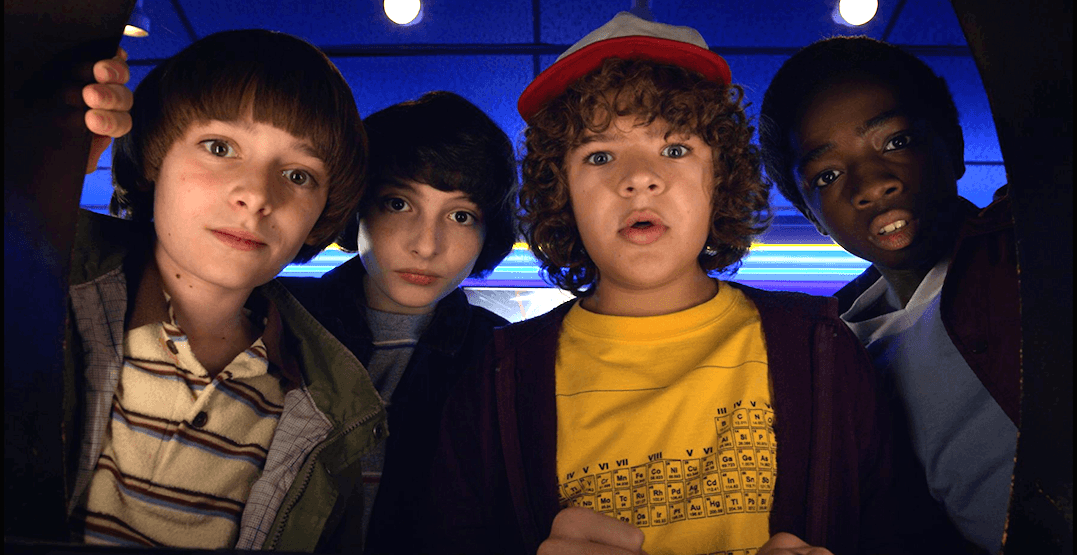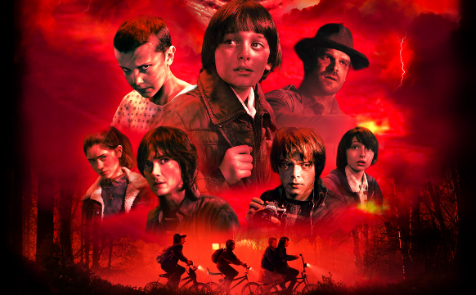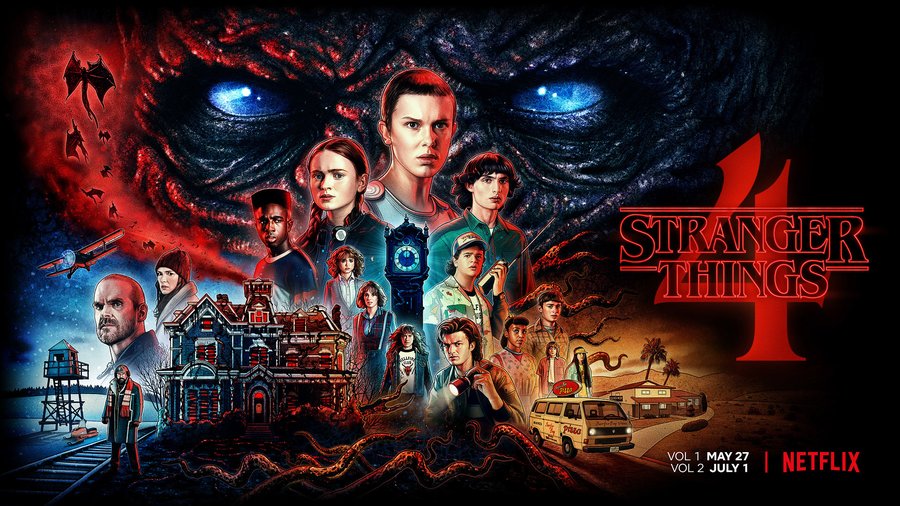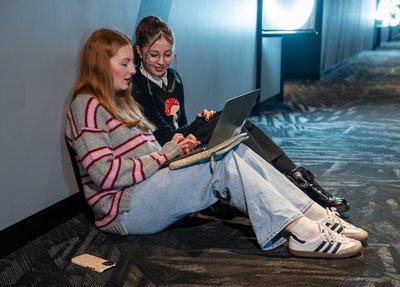
Can my child watch Stranger Things?

Noam on Nov. 27, 2025
The supernatural thriller series might appeal to younger audiences, with many having aged through their teen years as the show released new seasons every year or two. Because of this, each season tends to have more graphic content than the previous one.
Here are the content warnings for each season:
Stranger Things is set in the 1980s in the small town of Hawkins, Indiana, where a young boy mysteriously disappears, leading his friends and family to uncover a secret government lab conducting dangerous experiments. Their search reveals a terrifying alternate dimension called the Upside Down, inhabited by monstrous creatures. As they fight to rescue their friend and stop the growing threat, they encounter Eleven, a girl with mysterious superpowers who becomes key to the battle against sinister forces. The series blends horror, science fiction, and heartfelt coming-of-age drama.
In this blog, we provide you with information about the show so you can make the best watching choice for you and your whānau.
Season 5 – New Season, 27 November
This season will be the finale – the end to the Hawkins teens’ battle against evil. Consisting of eight episodes, it is set to be released in three parts, with the first volume dropping on November 27.
Is Stranger Things right for my whānau? What younger rangatahi need to know
The early seasons strike a good balance. They’re scary, funny, and centred on a group of rebellious kids. Season one is self-rated M, and seasons two and three are 13. But season four takes' things up a notch, with darker themes, more threatening enemies, and gruesome supernatural attacks, so Netflix has self-rated it 16.
I grew up watching Stranger Things, and it still surprises me that season one came out more than nine years ago. Because I watched each season as it released, the shift into darker, scarier territory felt gradual.
But for younger rangatahi starting the series now, the jumps in intensity can feel much bigger when you’re binging it rather than experiencing those years-long gaps.
As the story progresses, the show gets noticeably darker and more intense, a big shift if you’re expecting the lighter, adventurous feel of season one. It’s worth checking out a quick content breakdown before pressing play, so everyone knows what they’re in for. For some whānau, the later seasons might be a bit much for younger viewers and could be better to watch together or save for when they’re older.
The series also covers a wide range of content, from offensive language and drugs to violence and sex. While most sexual references are mild or just innuendos, the violence and horror are graphic, tense, and full of jump scares.
Stranger Things Content Guide: What’s in Each Season (1–4)
To help you make informed choices about what seasons are suitable for your whānau, we've done a recap of some of the strongest content from the first four seasons:

Season 1 – M | Horror, violence
Recommended for mature audiences.
Season 1 introduces viewers to the horror and suspense of Stranger Things, with creepy environments, frightening creatures, and tense moments. Key examples include:
- Monsters attacking and eating people and animals (mostly offscreen).
- Children placed in dangerous situations.
- The “Upside Down” with unsettling imagery, including decomposing bodies and jump scares.
- A young girl experiencing trauma from a past incident.
- A man being shot in the head by government agents, staged as a suicide.
- Offensive language is present, including multiple uses of “f**k” and some slurs.
For more information check out our content breakdown of season 1.

Season 2 – 13 | Horror
Recommended for audiences 13 and older.
Season 2 ramps up the graphic violence and horror, with more intense scares and characters, including children, placed in serious danger. Some key moments include:
- Bloody aftermaths of monster attacks.
- Frightening creatures and frequent jump scares.
- Unsettling environments that heighten the tension.
- Sexual content is mild (mostly innuendos with one non-explicit sex scene), and offensive language is stronger and more frequent than in season one.
For more information check out our content breakdown of season 2.

Season 3 – 13 | Horror
Recommended for audiences 13 and older.
Season 3 steps up the intensity with strong graphic violence, disturbing imagery, and frequent horror moments. Some of the strongest examples include:
- Bodies melting and gore from monster attacks.
- A character being impaled multiple times.
- A scene where someone cuts into a pulsating wound to remove a parasite.
- The season also includes mind control, trauma flashbacks, frightening creatures, jump scares, and unsettling environments. Sexual references are mild, while offensive language is strong and frequent.
For more information check out our content breakdown of season 3.

Season 4 – 16 | Horror, graphic violence
Recommended for audiences 16 and older.
Season 4 has a clear jump in intensity, with far more graphic violence, darker themes, and a heavier, more frightening tone than previous seasons. Some of the strongest moments include:
- Innocent characters being lifted into the air and violently twisted and dislocated before being killed through mind control.
- A lab massacre where children and adults are murdered by a young person in an act of rage.
- Graphic scenes where flesh melts away or characters are attacked by monsters, including heads being bitten off.
- It also includes themes of self-harm, brainwashing, trauma, and strong offensive language.
For more information check out our content breakdown of season 4.
Positive Takeaways and Conversation Starters for Whānau
While Stranger Things gets darker each season, it also includes inspiring and positive messages.
Younger rangatahi may be motivated by moments of courage and leadership as the characters navigate danger and mystery. Strong, healthy relationships show the importance of standing up for friends and looking out for each other, even when it’s risky.
Watching the series together can be a great chance for whānau to talk about what they’re seeing and help young people think critically about it. Some questions to guide the conversation include:
- Ask them who their favourite character is and why?
- Are the characters’ actions realistic, or do they remind you of people you know?
- What do you think the show is trying to say about friendship, family, or loyalty?
- Why do you think the show includes scary or violent moments? What effect does it have on the story?
- How do adults in the show behave, and how does that compare to adults you know?
- Why might the writers have included scary, violent, or sexual content?
And remember: just because a series or movie is popular doesn’t mean anyone has to watch it. Giving rangatahi the choice to pause, skip, or stop watching can be an important way to support them.
Final Thoughts: The Finale is Here
Season 5 brings the epic conclusion to the Hawkins teens’ battle against evil, packed with suspense, adventure, and the moments that have made Stranger Things so compelling. Watching together is a great way for whānau to share the excitement, talk about courage, friendship, and tough choices, and help younger rangatahi think critically about what they’re seeing. So grab some snacks, settle in, and enjoy. It’s time to step into the Upside Down… safely from your living room!
Further reading:
- Navigating Early Horror Experiences: Don't Let Nostalgia Get in the Way of Good Choices! | Classification Office
- Brain development – how it works, why it matters
- When trauma is involved, there are no spoilers (Blog)
- Staying safe when your parenting downtime gets hijacked by tough storylines (Blog)
- For more information about ratings and content warnings for films and series in the Star Wars franchise, visit our Find a Rating tool
Subscribe to our blog
Stay up to date with the Classification Office blog.


